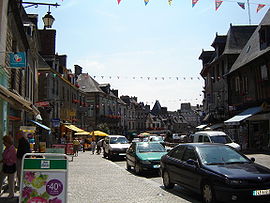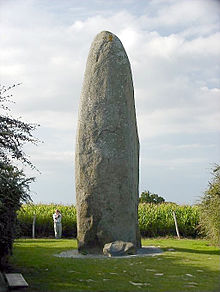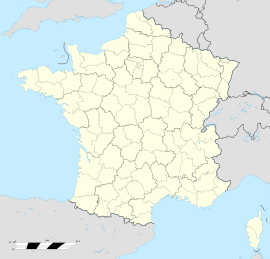- Dol-de-Bretagne
-
Dol-de-Bretagne
Dol
Administration Country France Region Brittany Department Ille-et-Vilaine Arrondissement Saint-Malo Canton Dol-de-Bretagne Intercommunality Pays de Dol-de-Bretagne Mayor Denis Rapinel
(2008–2014)Statistics Elevation 1–58 m (3.3–190 ft)
(avg. 16 m/52 ft)Land area1 15.53 km2 (6.00 sq mi) Population2 4,563 (1999) - Density 294 /km2 (760 /sq mi) INSEE/Postal code 35095/ 35120 1 French Land Register data, which excludes lakes, ponds, glaciers > 1 km² (0.386 sq mi or 247 acres) and river estuaries. 2 Population without double counting: residents of multiple communes (e.g., students and military personnel) only counted once. Coordinates: 48°33′02″N 1°44′59″W / 48.550556°N 1.749722°W
Dol-de-Bretagne (Breton: Dol, Gallo: Dóu), cited in most historical records under its Breton name of Dol, is a commune in the Ille-et-Vilaine département in Brittany in north-western France.
Contents
History
 The Dol de Bretagne menhir, estimated weight is 125 to 150 tons
The Dol de Bretagne menhir, estimated weight is 125 to 150 tons
In 549, the Welsh Saint Teilo was documented as coming to Dol where he joined Samson of Dol and to this very day the fruit groves which they planted remain and are known as the groves of Teilo and Samson. [1]Legend has it that while there he was assigned by King Budic II to subdue a belligerent winged dragon, which he was said to have tamed and then tied to a rock in the sea off Brittany.[1] He is reported to have stayed in Dol for seven years and seven months so must have left in 556 or 557.
Dol-de-Bretagne is reputed to be the origin of the royal House of Stewart who became the monarchs of Scotland and later England and Ireland; a plaque in Dol commemorates that origin. The Stewart monarchs descend from the Seneschal of the Count of Dol and his son, Flaad Fitzalan, who arrived in Britain in the army of William the Conqueror.
Flaad's grandson, Walter Fitzalan, was appointed the 1st Steward of Scotland by David I of Scotland. Malcolm IV of Scotland later confirmed the honour bestowed by David and made the office of Steward of Scotland hereditary in Walter's family.
Dol Cathedral is a significant building in an eclectic mix of styles.
In the fourteenth century, Walter Stewart (so named for his family's hereditary possession of the office of High Steward of Scotland), a descendant of Walter Fitzalan, married Marjorie Bruce, daughter of King Robert I of Scotland. Their son became King Robert II, and their descendants the royal House of Stewart.
In June 1173 Hugh de Kevelioc, 5th Earl of Chester, laid siege to Dol-de-Bretagne and captured the settlement as part of the Revolt of 1173–1174 against Henry II of England. Henry II, supported by an army of 20,000 mercenaries retook Dol-de-Bretagne the same year.[2]
Located near the town is Cricket Club Des Ormes,[3] which in 2003 set a world record for the longest cricket match. The club played for 26 hours and 13 minutes. The record has been beaten a number of times since.
Demographics
Inhabitants of Dol-de-Bretagne are called Dolois.
Historical population of Dol-de-Bretagne 1962 1968 1975 1982 1990 1999 2004 4483 4497 4624 4660 4629 4563 4774 From the year 1962 on: population without double counting—residents of multiple communes (e.g. students and military personnel) are counted only once. See also
- Communes of the Ille-et-Vilaine department
- List of megalithic sites
References
- Notes
- ^ a b "Who was St Teilo?". Stteilosbishopton.co.uk. http://www.stteilosbishopston.co.uk/stteilo/stteilo.htm. Retrieved 29 March 2011.
- ^ Flori 1999, p. 33.
- ^ Cricket Club Des Ormes
- Bibliography
- Flori, Jean (1999), Richard the Lionheart: Knight and King, Edinburgh: Edinburgh University Press, ISBN 978-0-7486-2047-0
External links
- Official website (French)
- Cultural Heritage (French)
- Pictures of Archangel Bay (French)
Categories:- Communes of Ille-et-Vilaine
- Ille-et-Vilaine geography stubs
Wikimedia Foundation. 2010.


